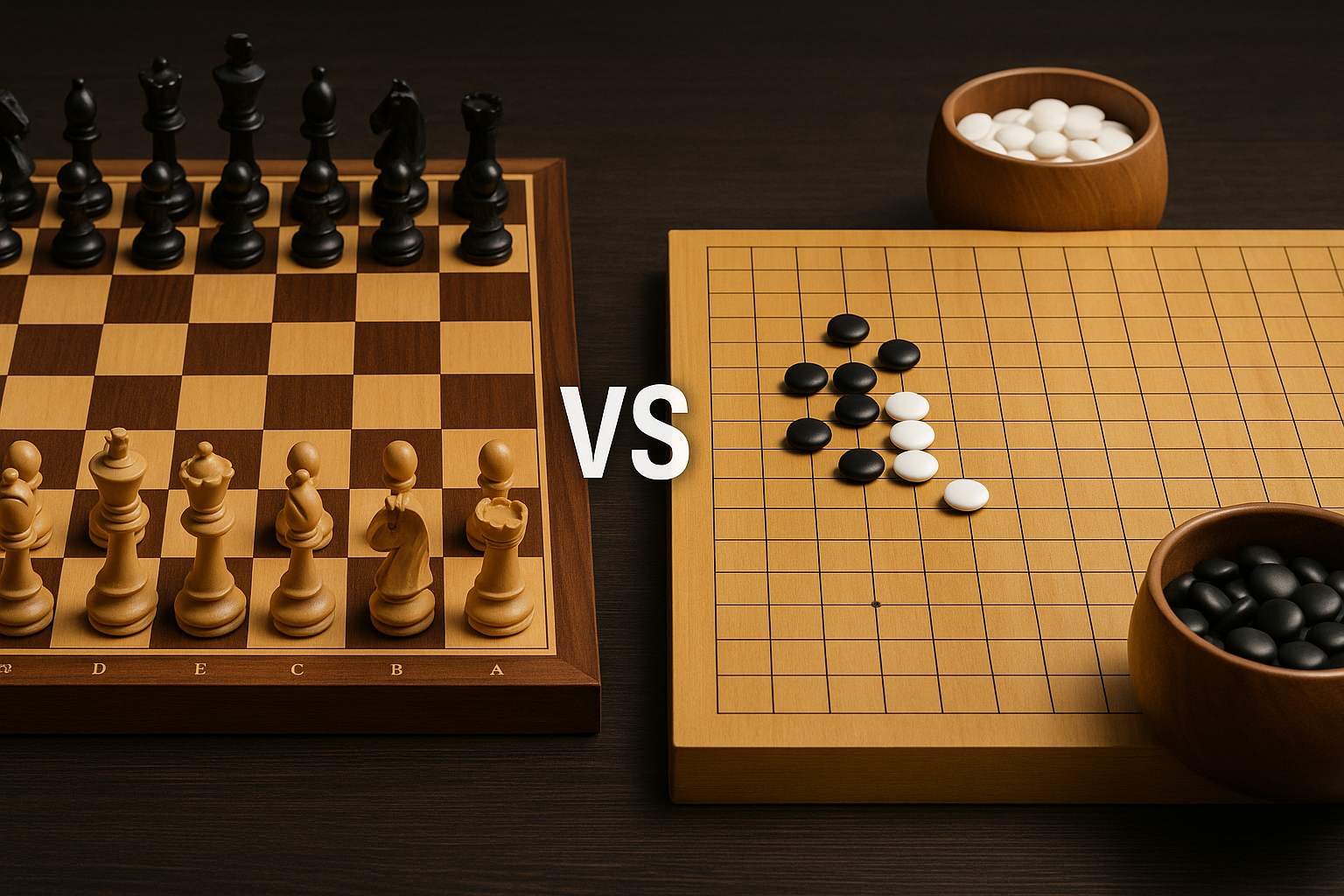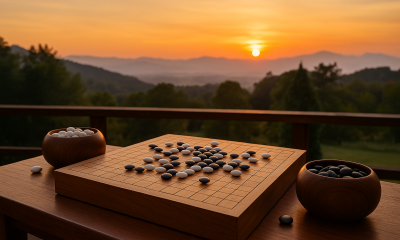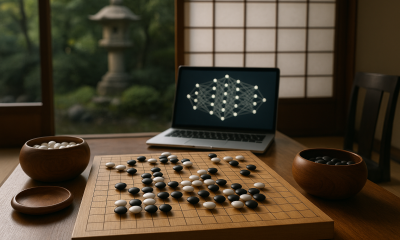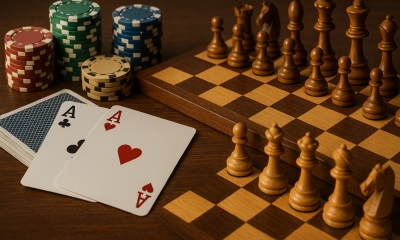News
Chess vs Go: The Battle of Perfect-Information Giants

For millennia, two strategy games have stood as enduring monuments to human intellect: Chess, arising from ancient India and Persia, and Go, steeped in East Asian tradition. Both belong to the class of perfect-information games—no hidden cards or dice—but each requires profoundly different skills, mindsets, and cognitive architecture.
If you followed the strategic depth in Poker vs Chess, this comparison of chess and Go explores a parallel terrain: raw logic meets holistic intuition.
1. Historical and Cultural Lineage
Chess: From Chaturanga to Grandmasters
Chess traces back to chaturanga, an early Indian war simulation. It evolved into shatranj through Persia, and later birthed modern variants in Europe with added complexity like the queen’s powerful moves. A robust resource for exploring its history and theory is Chess.com.
Over time, chess became a metaphor for structured conflict—armies, hierarchies, and tactical warfare projected onto a 64-square battlefield. The game matured not only as entertainment but as an intellectual discipline, with evolving opening theory, endgame study, and a global ecosystem of grandmasters.
Go: Ancient Harmony, Modern Intuition
Go is far older—its roots extend more than 2,500 years. Known as weiqi in China, igo in Japan, and baduk in Korea, the game embodies Eastern philosophies of balance, influence, and spatial subtlety.
Go’s modern AI renaissance was triggered by AlphaGo, the DeepMind project that catapulted the game into the spotlight by defeating world champions and redefining what “intuition” means in strategy.
Instead of armies and hierarchies, Go is about territory, connectivity, and influence. Each move is a brushstroke on an empty canvas, building shapes whose power emerges through interaction, not isolated strength.
2. Structural Complexity: Boards, Moves & Combinatorics
| Dimension | Chess | Go |
|---|---|---|
| Board size | 8×8 (64 squares) | 19×19 (361 intersections) |
| Units | 16 pieces per side, each unique | Hundreds of identical black & white stones |
| Move mechanics | Piece movement, captures, special rules | Stone placement, encirclement captures |
| Victory goal | Checkmate the king | Control more territory than opponent |
| Game type | Sequential, zero-sum, deterministic | Same |
| Information | Perfect, public | Perfect, public |
In chess, the board begins fully populated and the dynamics center on movement, exchanges, and tactical motifs. In Go, the board starts empty; influence radiates outward as stones accumulate. Local decisions cast global shadows.
The estimated game-tree complexity of chess is on the order of 10120, famously captured in Shannon’s lower bound for possible chess games. Meanwhile, Go’s branching factor is immense—often quoted near 250 possible moves per turn—and the combinatorial explosion dwarfs chess’s scale. Some estimations argue Go’s complexity exceeds 10700 potential games. [See forums estimating chess vs Go game tree complexity]
Chess’s state-space complexity, factoring in piece permutations, promotions, and legal configurations, is also vast. One upper-bound estimate even uses 1364 as a loose envelope. Chess.com analyzed these bounds.
3. Decision Modes: Calculation vs Intuition
Chess’s Deep Calculation
Chess players train to visualize forced lines, combinations, and tactical sequences many moves deep. The game rewards precision: a single overlooked tactic often costs material or the game.
Positional judgment—pawn structure, weak squares, piece coordination—guides pruning. Masters maintain mental heuristics to eliminate unpromising branches, relying on experience and pattern databases.
Go’s Fluid Intuition
In Go, brute-force search is infeasible across most positions. Players lean on pattern recognition, shape heuristics, and global balance. A single stone’s worth can’t be judged in isolation; rather it interacts with the entire board.
Key concepts include aji (latent potential) and sente / gote (initiative), reflecting how influence and timing matter more than immediate gains. Intuition guides zone judgment; local reading complements it.
4. Time, Tempo, and Initiative
Chess moves shift tempo directly—losing or gaining a move can change evaluation drastically. Concepts like *zugzwang* (being forced into disadvantageous moves) and opposition matter deeply. Time controls force players into difficult trade-offs between depth and survival.
In Go, tempo is more contextual. A move played in sente pressurizes the opponent; a gote move concedes initiative. Because areas interact, tempo is rarely absolute but relational across multiple fights.
5. Cognitive and Neural Profiles
Evidence suggests chess engages analytical, symbolic, left-hemisphere networks: calculation, memory, logic. Go activates holistic, visual-spatial regions, integrating patterns and relationships. In short: chess is decomposition, Go is synthesis.
The contrast mirrors cultural philosophies: Western tradition often prizes reductionist thinking; Eastern thought emphasizes holism and relational systems.
6. AI Milestones and Paradigm Shifts
Deep Blue and Modern Chess Engines
In 1997, Deep Blue defeated world champion Garry Kasparov using brute-force search augmented by heuristics. Chess AI since then has evolved with engines like Stockfish and Leela Chess Zero, blending deep search and neural evaluation.
These engines embody “perfect play” in many domains, reshaping human study and theory.
AlphaGo and Go’s AI Revolution
Go challenged conventional AI approaches until AlphaGo combined neural networks and Monte Carlo tree search to defeat top professionals. Its impact was transformative—in both Go strategy and AI methodology. AlphaGo’s Wikipedia entry captures the arc.
Today, open-source engines like KataGo refine that legacy, enabling amateurs and pros alike to leverage AI analysis. KataGo’s Wikipedia page details its capabilities.
Even with superhuman strength, Go-AI systems exhibit surprising failure modes—e.g. tricks that coax them into passing prematurely or creating unsafe shapes. Recent research highlights these exploits.
7. Pathways to Mastery
Chess Training Regimen
- Tactical drills (pins, forks, discovered attacks)
- Opening preparation and repertoires
- Positional themes, strategic planning
- Endgame technique
- Post-game analysis with engine feedback
Chess feedback is binary and immediate: a mistake shows up clearly in evaluation shifts. Progress is easily measured by Elo or Glicko ratings.
Go Training Regimen
- Tsumego: life & death puzzles
- Fuseki / Joseki: standard opening shapes
- Whole-board judgment and shape reading
- Review with AI tools (e.g. KataGo)
Go rewards judgment calibration over absolute correctness. Many moves are viable; the challenge lies in choosing optimal harmony and influence over time.
8. Measuring Skill and Progress
Chess uses Elo and Glicko systems, awarding titles like Grandmaster via norms. Go uses kyu/dan scales; professional ranks are earned through high-stakes leagues.
The chasm between a strong amateur and a top professional is steep in both games—a testament to the depth beneath the surface.
9. Philosophical Dimensions
Chess represents conflict, structure, and result. Every game ends with a clear outcome: checkmate, draw, or resignation. Its metaphor lies in war and logical assertion.
Go, by contrast, is about balance, adaptation, and emergent beauty. Stones live and die, shapes breathe, influence shifts. Victory is often minimalist—control, not domination.
10. Emotional and Psychological Landscape
Chess players face peaks of tension and valleys of collapse. A blunder can instantly flip the game. Mental resilience, focus, and tilt avoidance are essential.
Go’s pace demands endurance. Mistakes often carry less immediate punishment, allowing recovery. Patience and calm deliberation become virtues more than raw aggression.
11. Popularity, Platforms & Communities
Chess has enjoyed mass adoption thanks to digital platforms. Chess.com is not only a learning hub but a broadcast platform, tournament venue, and community center.
Go, while more niche, thrives via servers like OGS Online Go Server and Fox Go Server. AI tools have amplified accessibility, letting amateurs train with pro-level analysis.
12. Cross-Disciplinary Insights
Transitioning between chess and Go yields surprising benefits. A chess player may sharpen tactical acuity; a Go player may deepen holistic judgment. Combined, they foster flexible thinking, self-reflection, and strategic intuition.
13. Intelligence & Strategic Lessons
Chess teaches logical progression, causality, and precise optimization. Go teaches context, harmony, and emergent strategy. One is “thinking ahead,” the other “feeling forward.”
14. The Road Ahead: Evolution & Unanswered Questions
Even in the wake of AI dominion, human interest in both games deepens. Go’s post-AlphaGo era asks new questions: how close are we to perfect play? Can humans catch up? What is the minimal energy for optimal play? “The Game Is Not Over Yet” explores this frontier.
Similarly, chess continues to evolve: engine evaluations now include concepts like entropy and move variation complexity, helping humans understand depth beyond mere numbers. “Chess variation entropy and engine relevance for humans” explores this frontier.
15. Hardness: Which Game Is More Difficult?
This depends on perspective:
- Computational hardness: Go is overwhelmingly more complex
- Learning clarity: Chess offers a more linear progression
- Philosophical richness: Each is deep in different axes
Go challenges intuition and balance; chess challenges precision and clarity.
16. Broad Lessons Beyond the Board
Chess teaches structure, predictability, and optimized planning. Go teaches adaptability, influence, and recognizing emergent patterns.
In summary: Chess rewards knowing; Go rewards seeing.
Conclusion
Chess and Go stand as twin pillars of strategic cognition. One is sharp, linear, and forceful. The other is organic, flowing, and relational. Together they chart the contours of human reasoning—from logic to perception.
Having explored the bridges between chess, Go, and card games like Poker vs Chess, you can see how strategy manifests differently depending on the rules and structure. Let me know if you need this version with SEO metadata, anchor links, or further internal cross-links across Gaming.net.













